Between the cities of Zacatecas and Jalpa runs a 100 mile long valley called Malpaso. The valley is about 20 miles wide, with mountains running down each side. Through this valley runs route 54, a mostly small twin lane road following the flat valley floor. The land is high desert – 8,000 feet – with green-dinner-plate-sized spiny cactus, scrub brush, and the occasional group of dry trees.
About half way between the two cities is a hill upon which sits La Quemada, the hill is anomaly set in the middle of the flat valley, while the ruins La Quemada is an enigma this far north in Mexico.
The number one fact about La Quemada, -‘The Burnt One’- the fact that each sign, book and website relates first, is that no one really knows who built this site. And it’s not like it is a small site, it had the largest roofed building in the whole of the America’s for its day.
Scattered about the site are informational plaques. One of them lists the theories on who built this fortress and ceremonial site: “It has been considered a Teotihuacan enclave, a Toltec emporium, a Tarascan bastion, the Chicomostoc of the Aztec legends, and a Caxan center, among others”
The hill is not that big, I guess it took Susan and I an hour and a half to get to the top,
[upon the top of La Qemada]
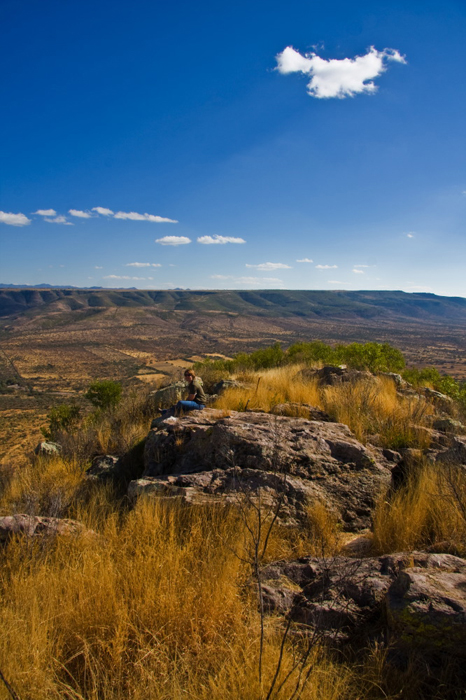
but before we climbed to the top, we began our journey up the hill in the clean and modern museum next to the car park. The night before Susan and I visited La Quemada, Saturday Jan 31, I had been invited to attend a night camping under the stars at this site, but decided, as there were no cameras allowed, and the evening would be filled with astronomy lectures in Spanish – despite the fact that I like astronomy lectures – just not in a language I don’t understand. Two thousand people were expected to camp out for the evening and learn about the stars, but an estimated 4000 showed up. Maybe I should have gone.
What was I talking about? Oh yes, the modern museum, which had beautiful cactus growing in front of its modern stone walls.
[Cactus in front of La Quemada museum]

Inside the doors of the museum, is a miniature of the historic site.
[I added my own indicators of the significant buildings.]
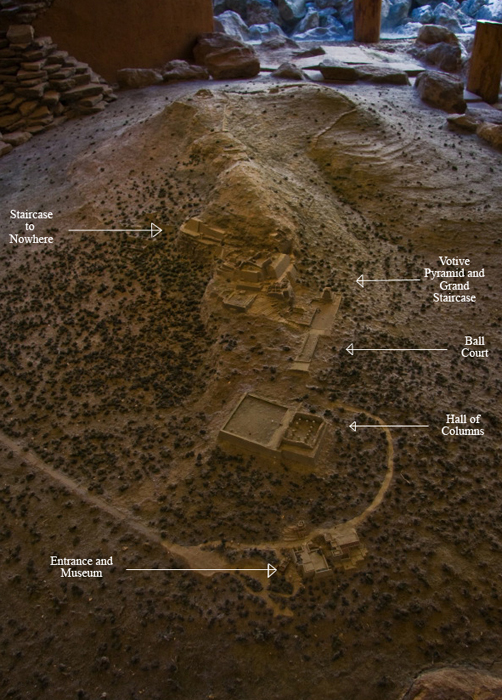
Inside the museum were many pieces of pottery, which have never really interested me, but off to one side was a display of the work of the archaeologists. It was a recreation of the different layers they had to dig through to reach the good stuff underneath. First they had to dig through the modern sewing machines, car rims and windshields:
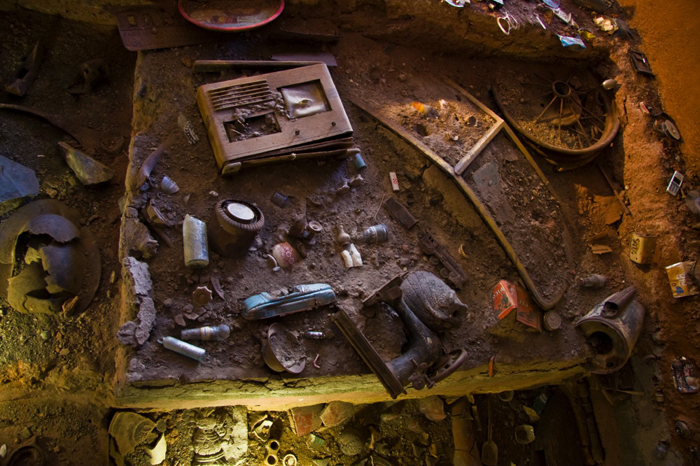
In order to get to the bones and the rifles underneath.
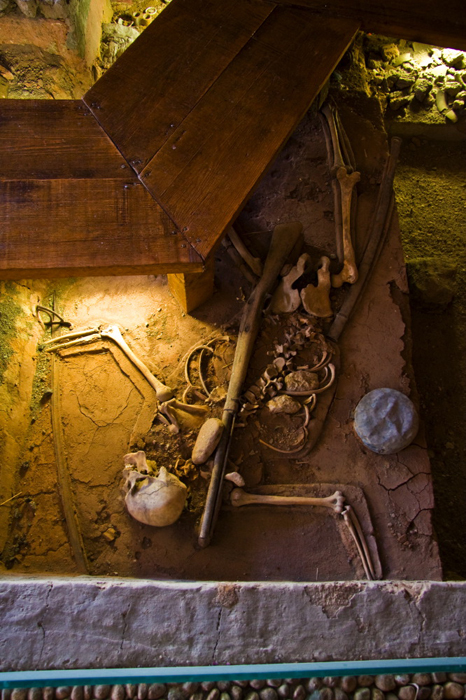
Out of the museum, and following the path up the hill, there are towering, thick walls. They are made from small stones from the surrounding area loosely piled on each other in perfect smooth lines. But the stones were not always visible, when the site was originally built -between the years 500 and 900 – the stones were mortared together with clay and vegetable fiber, and then covered with layers of mud and finally whitewashed. The mud and the mortar has been removed by the elements and the passage of time.
The walls were not just ceremonial, or to keep the terraces from falling down, but as fortifications against invaders.
Which seems to have eventually failed.
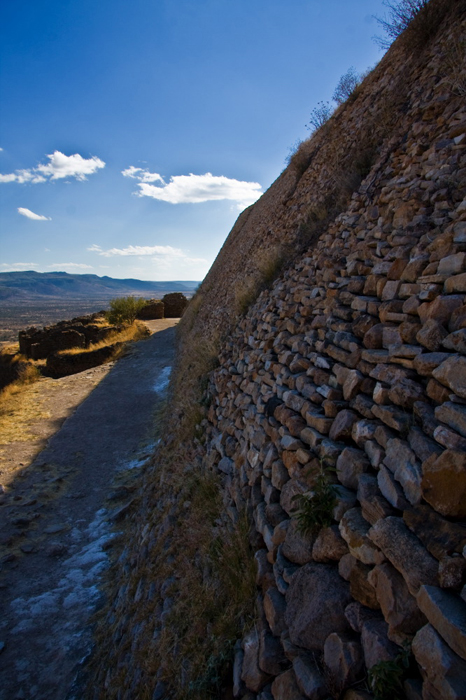
The first structure we visited, near the bottom of the hill, was the Hall of Columns. It is a large walled space with round stone columns symmetrically aligned.
[Susan inadvertantly demostrates the size of the columns]
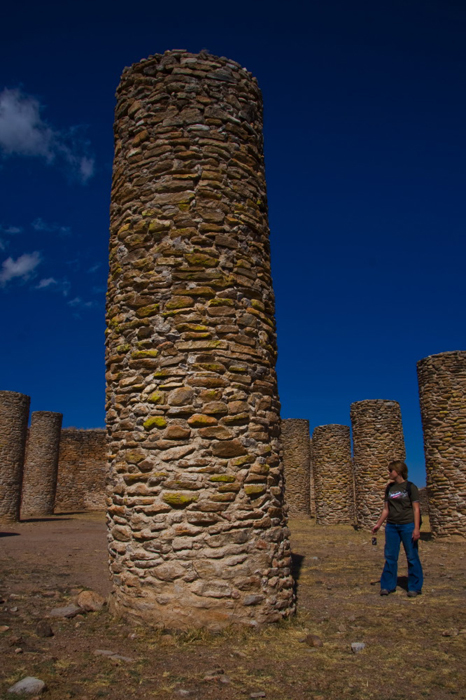
The interior space is 41 meters by 30 meters (135 feet by 100 feet), with the columns 5 meters (15 feet) tall. The informational plaque read: “The remains of the 12 columns, which are seen inside, served as roof supports. They sustained large beams on which were placed a covering of wooden rods and finally, a layer of adobe mud 12 cm. thick.”
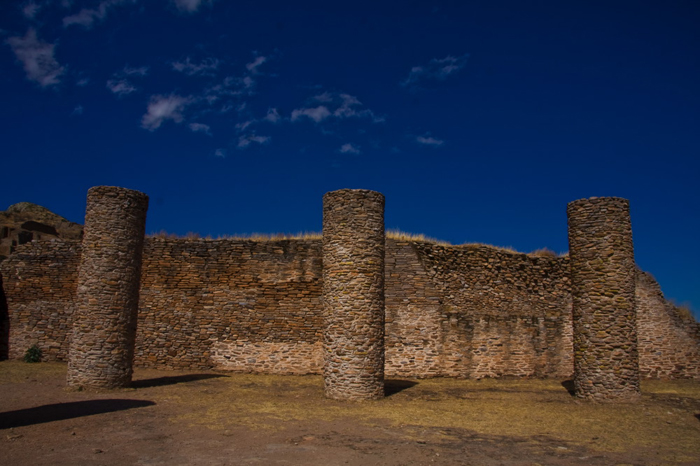
When excavated, the floor of this cavernous room was covered with a layer of burnt wood carbon and baked clay, which led the archaeologists to conjecture that it was destroyed by fire. As the site was abandoned somewhere near the year 900, and from the large defensive walls, it is conjectured that the city was attacked, looted and set on fire at that time. It also might be the reason why it is called “The Burnt One”.
This room is assumed – for its time – to be the largest roofed enclosure in the Americas.
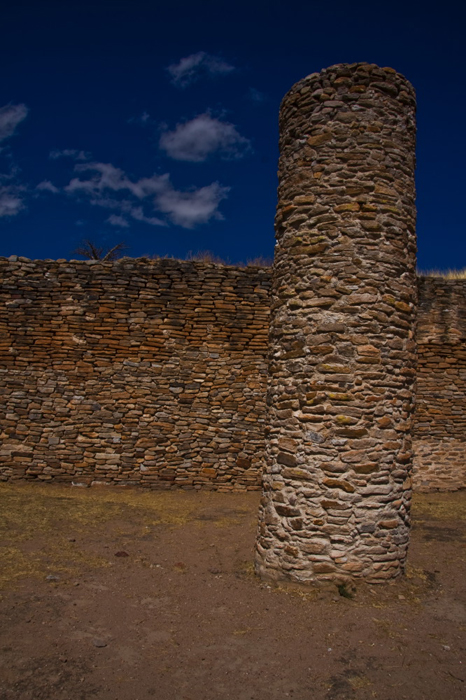
Also found in the Northeast corner of this room was a concentration of human bone fragments. Which suggests ritual use, or maybe even human sacrifice.
Just north of the Hall of Columns is the Juego de Pelota (Ball Court). The rectangular court is 70 meters (230 feet) long and excavation has found numerous layers of polished clay which suggests much use and much maintenance. Underneath the clay floor is also evidence of human burials, which suggests that not only were the games used for a religious function, such as fertility cults or solar cycle festivals, but also as human sacrifice.
[The steps entering the Ball Court]

[View looking down on the Votive Pyramid on the left and the -half hidden- Ball Court on the right.]
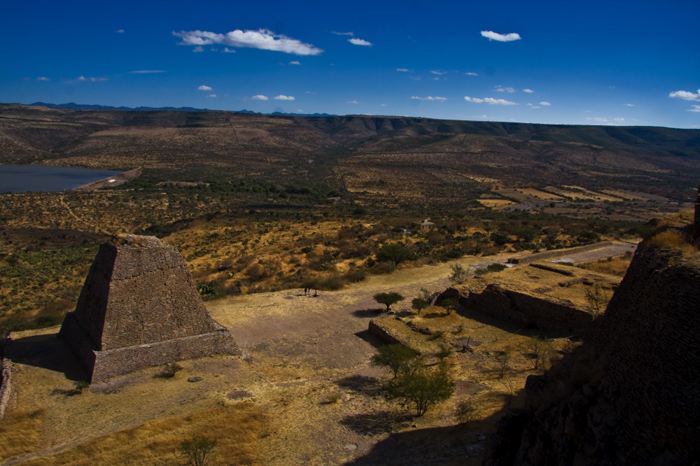
At the end of the Ball Court, is the Votive Pyramid.
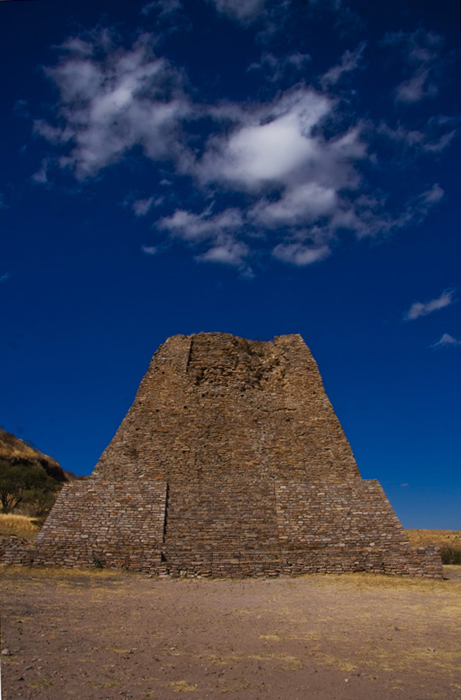
LIke other buildings on this site, this pyramid used to be covered with an outer coating of dried mud, and as this was a ceremonial building, there was an altar on top, which of course would have been used for human sacrifice.
That phrase, human sacrifice, keeps popping up about various different areas on this hill, I wonder how true it is, and what really happened here.
From an informational plaque: “In excavating it, skeletal remains of some 250 individuals were found mainly in the area at the foot of the pyramid, apparently deposited there by the inhabitants of La Quemada on the eve of its abandonment. Many of the long bones show traces of having been cut. Some of the skulls show perforations which indicate that they were hung somewhere prior to being deposited here. On the top of the pyramid, remains of a small shrine were discovered built of adobe with numerous skulls, jawbones and long bones.”
In the museum is a recreation of what is thought the shrine with dangling bones looked like.
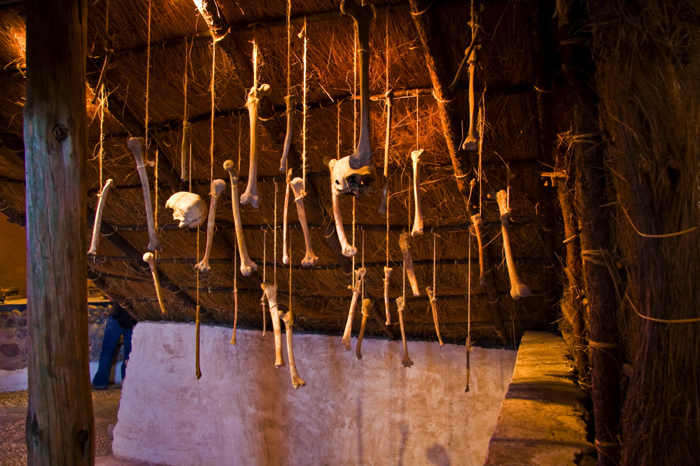
To the left of the the Pyramid is the Grand Staicase, leading from what seems to be mostly ceremonial buildings to resdences.
[Children climbing down the Grand Staricase]
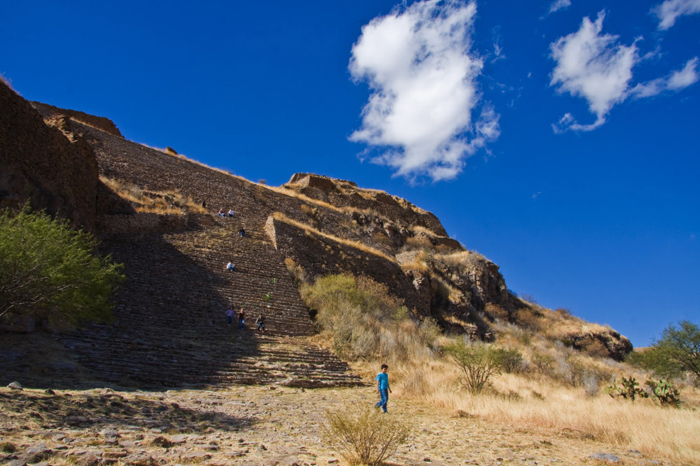
[and then they climb upon the Votive Pyramid]
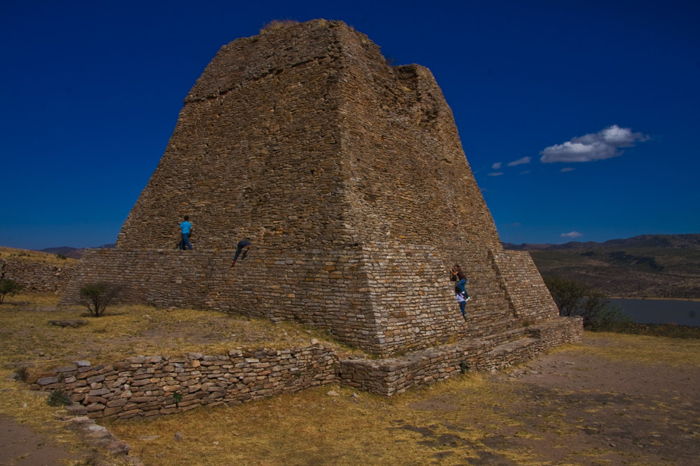
[Random photograph of defensive walls next to Ball Court]
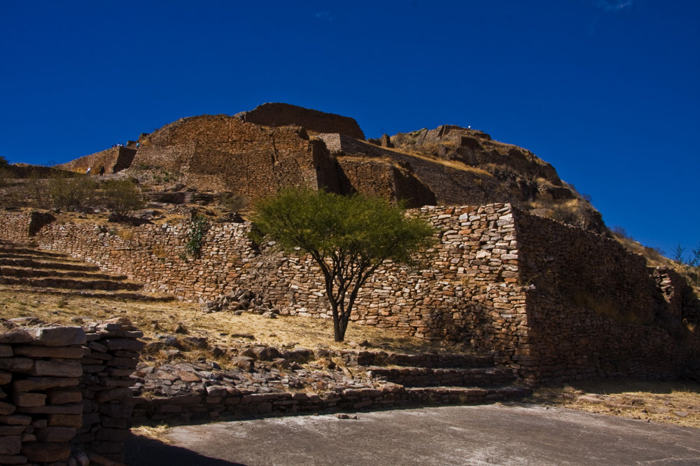
[Random photograph looking north, or up the hill, next to the Hall of Columns.]

At the top of the staircase, on the next level of terraces, there is a clear veiw over the flat countryside. The clouds sit quetly in the sky, as a patchwork of fields and lines lead out from La Quemada into the distance. I notice some unusually straight lines leading from the mountain around the valley. I turn to Susan with a sarcastic grin, and poking her lightly on the shoulder say, “you see those lines, they were probably built by aliens.”
Susan looked up at me with eyes that questioned my sanity, and said even more sarcastically, “Yes, they look exactly like the fences that border farms. Which means they must have been built by aliens.”
I paused for a moment, and then continued my train of thought, “but the latest Indiana Jones movie said there were aliens round here, you know, the ones with those big skulls,” she kept staring at me, like she was contemplating which nut farm to send me to, so I continued, “ya know, Indy would not lie to us, like that golden box that holds god’s power, or that guy that could pull a beating heart out of someone’s chest, or, um, what was the third movie about? Oh, yea, it had Sean Connery.” She turned her back on me and continued to walk up the hill, and I followed.
[Men relaxing on the Grand Staircase, with the Votive Pyramid in the foreground, and faintly -in the top right corner- the perfectly straight lines built by, of course, aliens.]
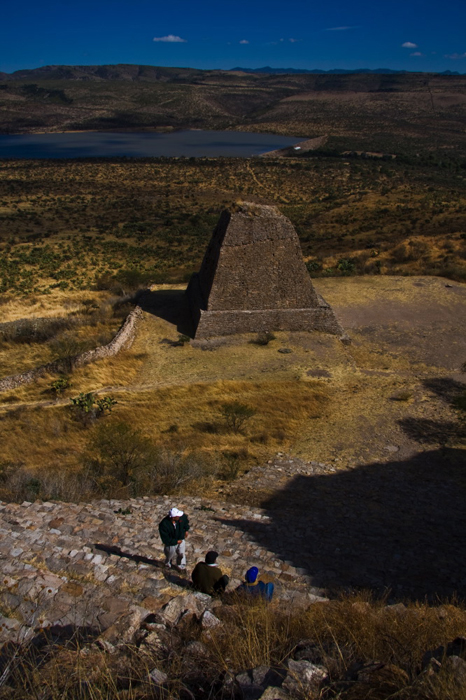
[Detail view of stone wall missing its mortar.]
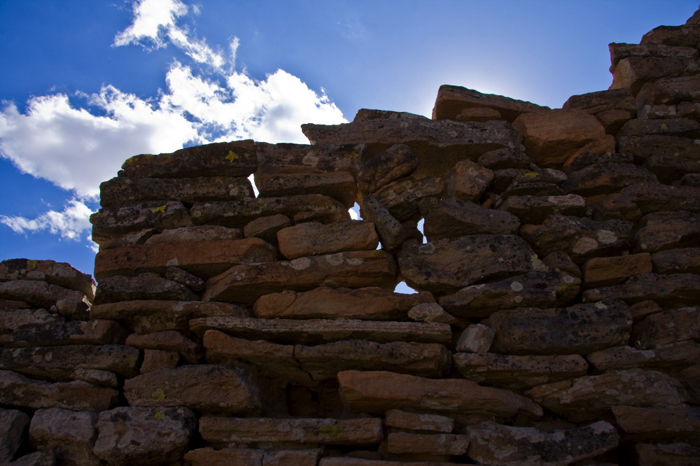
[View looking south into the valley.]
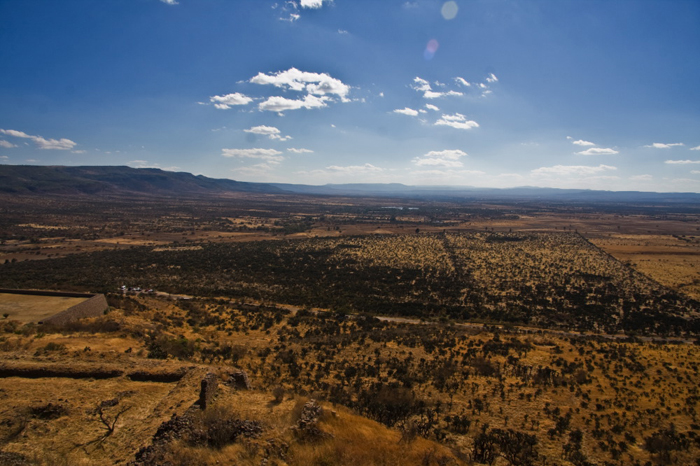
While standing and looking over the valley to the south, I turned to the west and looked at a set of cliffs. And noticed a set of stairs leading to the edge of the cliff. I wondered if these stairs had to do with human sacrifice or aliens, could not come to a conclusion, so I took a picture.
[View west with the ‘Stairway to Nowhere” -my designation, not an official name.]
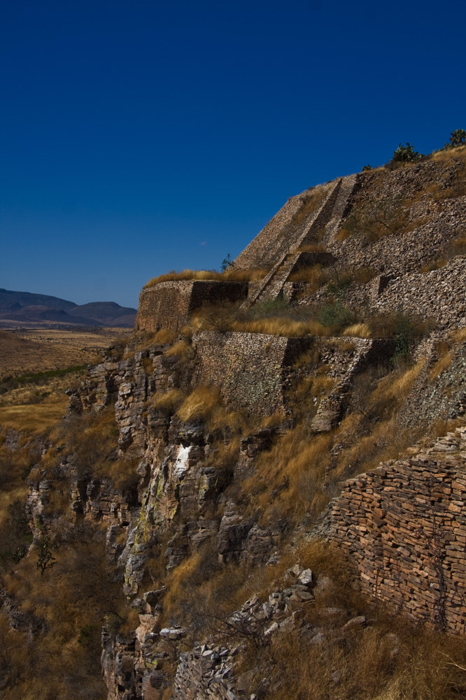
[Random photograph of wall and tree.]
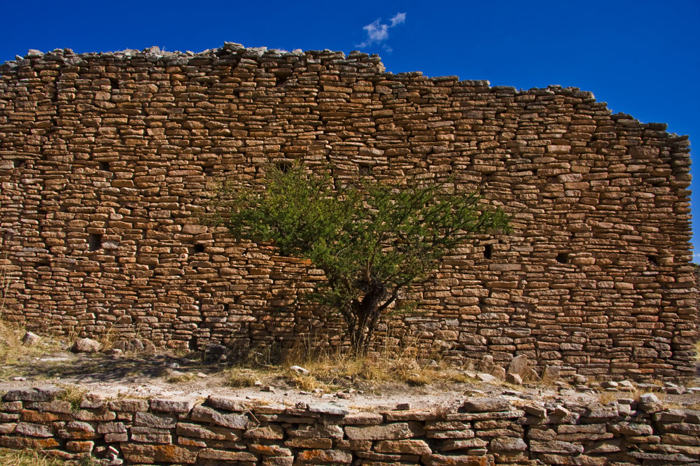
Near the top of the many terraces, was another plaque, which destroyed my fabulous alien theory.
It stated that the lines leading out from La Quemada are roads, -170 km (105 miles) of them – which lead all around the valley. It seems, most of the population lived in 200 villages or hamlets surrounding La Quemeda. La Quemeda was used primeraly as a ceremonial site – or forterss as necessary – and only the priests or leading gentry lived there. The roads were build of stone slabs and clay, and have survived because the local farming tools could not break up the stones. But that is changing with the advent of modern farming equipment.
Finally Susan and I sat atop the hill, overlooking the whole valley, enjoying the warm sun and the cool breeze. And discussed why the last Indiana Jones film was so bad.

Do you have a “beautiful” filter or is Mexico just really that beautiful? You know what I love about the collection above? Not one logo anywhere. It’s hard to imagine that civilization is possible without logos plastered all over everything. A lot of your photos are logo free. It’s like… a relief to not have to process logos and ads. These are really beautiful… not just subject, they are compositionally excellent (but I expect this from you), and such a variety. What a beautiful day. I feel like I was there!
We also discussed the lack of pubs at the top. Don’t forget the boose.